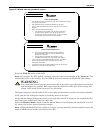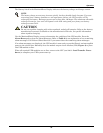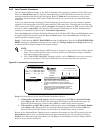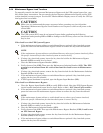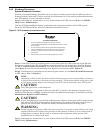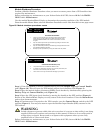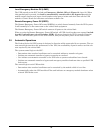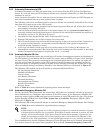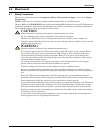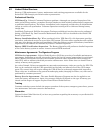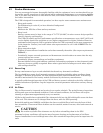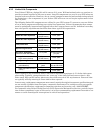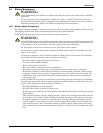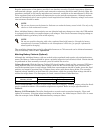
Operation
97
3.5.3 Automatic Retransfers to UPS
Automatic Retransfer to UPS is an option that you can select from the SCC System Configuration
screen. If you do not want the UPS system to initiate any automatic retransfers, set Max Auto-Rexfer
Attempts to zero (0).
In an automatic retransfer, the two motorized circuit breakers (System Bypass and UPS Output) are
both closed simultaneously for a short period of time (overlap).
The following critical bus conditions must be present to initiate an automatic retransfer of the critical
load from the bypass source to the UPS system:
1. The number of Auto-Rexfer Attempts selected must be greater than zero (0). If zero (0) is selected,
no automatic retransfers will occur.
2. Critical load was initially transferred to the bypass source due to a system overload only. (A
manually initiated retransfer from bypass is required if the critical load exceeded the capacity of
the modules on-line or if a UPS fault occurred.).
3. Overload has since dropped below 100% of the rated SCC current.
4. Enough UPS modules are on-line to supply the critical load.
5. OK to Transfer signal received from the control logic for at least 10 seconds, within 5 minutes of
the system overload transfer. (A manually initiated retransfer from bypass is required for
overloads lasting 5 minutes or more.)
6. Cyclic-type overloads, which occur up to five (select range is 0 to 5) times in 60 minutes, are
automatically returned to the UPS system for each event including the Nth overload. A manually
initiated retransfer from bypass is required for the N + 1 overload.
3.5.4 Automatic Module Off-Line
For specified UPS module faults, the control logic will initiate an automatic isolation and shutdown of
the UPS module. In the Module Off-Line mode the output, battery (MBD) and input circuit breakers
are open. If the UPS system was operating in the redundant mode when the module was taken off-
line, the critical load will remain on the UPS system. If the UPS system was operating in the non-
redundant mode, an automatic transfer to bypass will be initiated. Note that the bypass line is usu-
ally not available during Low Battery Shutdown. One Module Off-Line is illustrated in Figure 57.
The following UPS module faults will initiate an automatic Module Off-Line:
DC Overvoltage Shutdown
Hardware Shutdown
Inverter Fault
Low-Battery Shutdown
Overload Shutdown
Overtemperature Timeout
Rectifier Fuse Blown
Reverse Power
Refer to Table 9 for more information regarding these alarm messages.
3.5.5 Automatic Emergency Modules Off
For the specified UPS system fault, the control logic will initiate an automatic transfer to bypass fol-
lowed immediately by a shutdown and isolation of the UPS system. In the Emergency Modules Off
mode the output, battery (MBD) and input circuit breakers at each UPS module are open. The System
Bypass Breaker (SBB) will be closed if the bypass line is available. Emergency Modules Off is
illustrated in Figure 59.
The following UPS system fault will initiate an automatic Emergency Modules Off: Output Over Voltage
Refer to Table 9 for more information regarding alarm messages.
Your installation may include a Remote Emergency Power Off mode that can be initiated automatically
by a contact closure in the critical load equipment. Refer to 3.3.8 - Remote Emergency Power Off.
NOTE
A load transfer to the bypass line will be completed whenever an automatic transfer to bypass
is initiated and the bypass line is available. If the OK to Transfer condition is present, the load
transfer will be uninterrupted. If the Static Switch Unable alarm message is present for any
reason, the automatic transfer will be interrupted for 40 to 120 milliseconds. Because of the
reliability of the UPS components, an interrupted load transfer is a very unlikely occurrence.



